A student influencer at Ircelyon
Ircelyon has welcomed to its CARE team, Clara Inés Alcolado Olivares, a PhD student known in Spain for sharing science videos on social networks. Sharing science with society is one of our missions, and meeting...
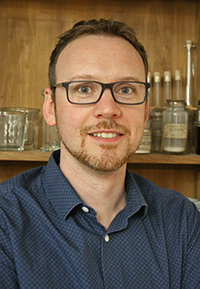
Laboratory council membre
Orcid number: 0000-0002-0458-3085
445 424 (Switchboard + 33 [0] 472 445 300)
P105
Molecular Catalysis, Metal-Organic Frameworks (MOF), Porous Organic Polymers (POP), Covalent Organic Frameworks (COF), Covalent Triazine Frameworks (CTF), Post-Synthetic Functionnalization, Confinement, Fine Chemicals, Photocatalysis, Carbon Dioxide (CO2), Asymmetry, Chirality, Macroligand
Molecular Hybrid Catalysts for Fine Chemicals Synthesis and Clean Energy Production
Jérôme Canivet was appointed CNRS researcher at the IRCELYON in 2010.
Within the ING group of IRCELYON, his "MOF team" accounts for 7 PhD students, postdocs and engineer and collaborates tightly with other CNRS permanent researchers in Lyon (DNP SENS), Lille (time-resolved spectroscopy) and Paris (computational chemistry).
His team develop new catalytic systems answering current challenges in fine chemicals synthesis and clean energy production by unravelling novel molecular catalysts and heterogenizing within Porous Macroligands, a concept he established for synergistically bridging homogeneous and heterogenous catalysis.
The "MOF team" research efforts are mainly funded by H2020 and ANR programs with projects going from TRL3 to TRL 5/6.
In 2018, he received the Young Investigator Award from the Catalysis Division of the French Chemical Society for creating trends reducing the gap between homogeneous and heterogeneous catalysis.
He further aims at exploiting the confinement of molecular catalytic systems into porous structures for the improvement of their catalytic activity and selectivity, and he is coordinating cooperative projects on this topic.
Career
2024- now: CNRS Research Director at IRCELYON, France.
2010- 2024: Permanent CNRS researcher at IRCELYON, France.
Principal Investigator on molecular hybrid materials for fine chemicals synthesis and photocatalysis
2009-2011: Postdoctoral research project done at the CNRS with Dr. David Farrusseng, Metal-organic frameworks from sorption to catalysis, IRCELYON, France.
2007-2009: Postdoctoral research project done at the Noyori’s Laboratory under the direction of the Prof. Kenichiro Itami, Catalyzed direct CH arylation, University of Nagoya, Japan.
2003-2007: Ph.D research project done at the Laboratory of Organometallic Chemistry and Molecular Catalysis directed by the Prof. Georg Süss-Fink, Synthesis of water-soluble arene ruthenium, rhodium and iridium complexes and study of their catalytic potential for the transfer hydrogenation reaction in aqueous solution, Chemistry Institute of Neuchâtel, Switzerland.
Education
University of Lyon (France): Professorial Thesis (Habilitation à Diriger des Recherches), 2017
University of Neuchâtel (Switzerland): Ph. D., Organometallic Synthesis and Molecular Catalysis, 2007
University of Lille (France): M. S., Organic and Macromolecular Chemistry, 2003
University of Lille (France): B. S., Physical and Chemical Sciences, 2001
Awards
2020: Green Chemistry Emerging Investigator, RSC
2019: CNRS research award for outstanding scientific contribution
2019: Emergence@International travel grant from Institute of Chemistry - CNRS (Japan lecture tour)
2018: Young Researcher Award from the Catalysis Division of the French Chemcial Society (DivCat)
2007: SNF Postdoctoral Fellowship for Prospective Researchers, Swiss National Science Foundation (supported by Prof. J.-E. Bäckvall, Stockholm University, Sweden).
2007: JSPS Postdoctoral Fellowship for Foreign Researchers, Japan Society for the Promotion of Science (supported by Prof. K. Itami, Nagoya University, Japan).
Research impact
as in Scopus on December 2024: 68 scientific papers (J.Am.Chem.Soc., Angew. Chem., Chem. Sci., ACS Catal., Green Chem... ), H index = 32, 4900 citations, > 350 citations/year
3 book chapters
5 patents
more than 55 lectures in international conferences including 15 invitations since 2010

Coordinator of the French ANR project PoMAC: Confinement of peptide sequences in Porous Macroligand for Asymmetric Catalysis see also the project page
Coordinator for CNRS of the European H2020 project H-CCAT: Solid Catalysts for activation of aromatic C-H bonds
for updated scientific production see
Follow us on Twitter MOF@IRCELYON
From Homogeneous to Heterogeneous Catalysis for Sustainable Chemical Processes
Environmentally friendly and cost efficient processes attract continuously growing interest for applications in catalysis and organic synthesis.
The main aim of my PhD work (2003-2007), in the Süss-Fink group at Neuchâtel University, Switzerland, was to develop efficient catalysts in aqueous solution, especially for transfer hydrogenation of ketones and imines to give an environmentally friendly access to alkaloids via asymmetric catalysis in water.
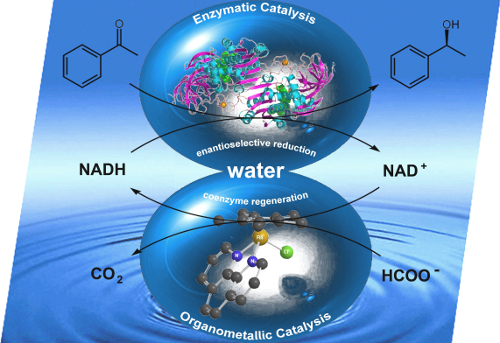
In this “green chemistry” concept, I extended my field of research to other catalytic reactions like carbon-carbon coupling and to self-assembled materials. Thus I joint the Itami group (2007-2009), first as a part of the Noyori Laboratory, in Nagoya, Japan, as a JSPS postdoctoral fellow in order to develop new systems (molecular catalysts and/or nanoparticles) able to catalyze the heteroarenes functionalization (via CH activation) under mild conditions, enhancing the cost efficiency of the process.

Since 2009, I joint the group of Engineering and Process Intensification at the CNRS in the Institute of Researches on Catalysis en Environment of Lyon (IRCELYON) in order to develop new catalysts based on the MOFs technology, expanding the field of applications of these promising porous crystalline materials. I therefore developed new catalytic species confined into the MOFs cavities in order to obtain innovative selectivities with heterogeneized molecular catalysts.
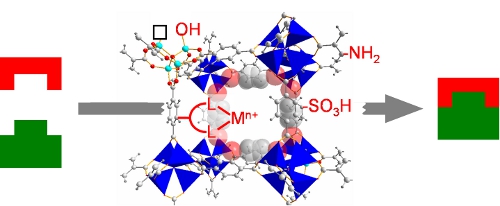
I developed the concept of solid macroligand, using MOF and microporous polymers as valuable representatives. We show that polymer-based macroligands allow designing heterogeneous catalysts with similar versatility than found in molecular chemistry and homogeneous catalysis.
Our main finding is that the Hammett parameter is a performing descriptor of all the active sites, irrespective of their nature (heterogeneous or molecular) and the Hammett parameter can be directly linked to the catalytic performance of the catalysts with no gap between homogeneous and heterogeneous catalysis. While the usefulness of the Hammett parameter is well established in molecular chemistry, no such evidence was present for heterogeneous/heterogenized catalysts so far. This perfect correlation has been established for Rh-based catalytic systems in both CO2 photoreduction (ACS Catal. 2018) and ketones transfer hydrogenation (ChemCatChem 2018).
The established correlation between the catalytic activity and the Hammett parameter highlights the crucial impact of the local electronic environment surrounding the active catalytic center over the long-range framework structure, as demonstrated for two different MOF and four CMP-based catalysts. The general linear trend gives also insight into the contribution of the diffusion limitation inside the porous network of such heterogeneous catalysts or of unexpected reactivity of functional groups at the macroligand.

This opens new perspectives for the rational design of efficient heterogeneous catalysts based on molecular species.
Both MOF and Microporous Polymers thus appear as very appealing platforms and their use as macroligands for the heterogenization of molecular catalysts is further reducing the gap between homogeneous and heterogeneous catalysis.
Fine chemicals synthesis and clean energy production
Jérôme Canivet's team develop new catalytic systems answering current challenges in fine chemicals synthesis and clean energy production by unravelling novel molecular catalysts and heterogenizing within Porous Macroligands, a concept we established for synergistically bridging homogeneous and heterogenous catalysis.
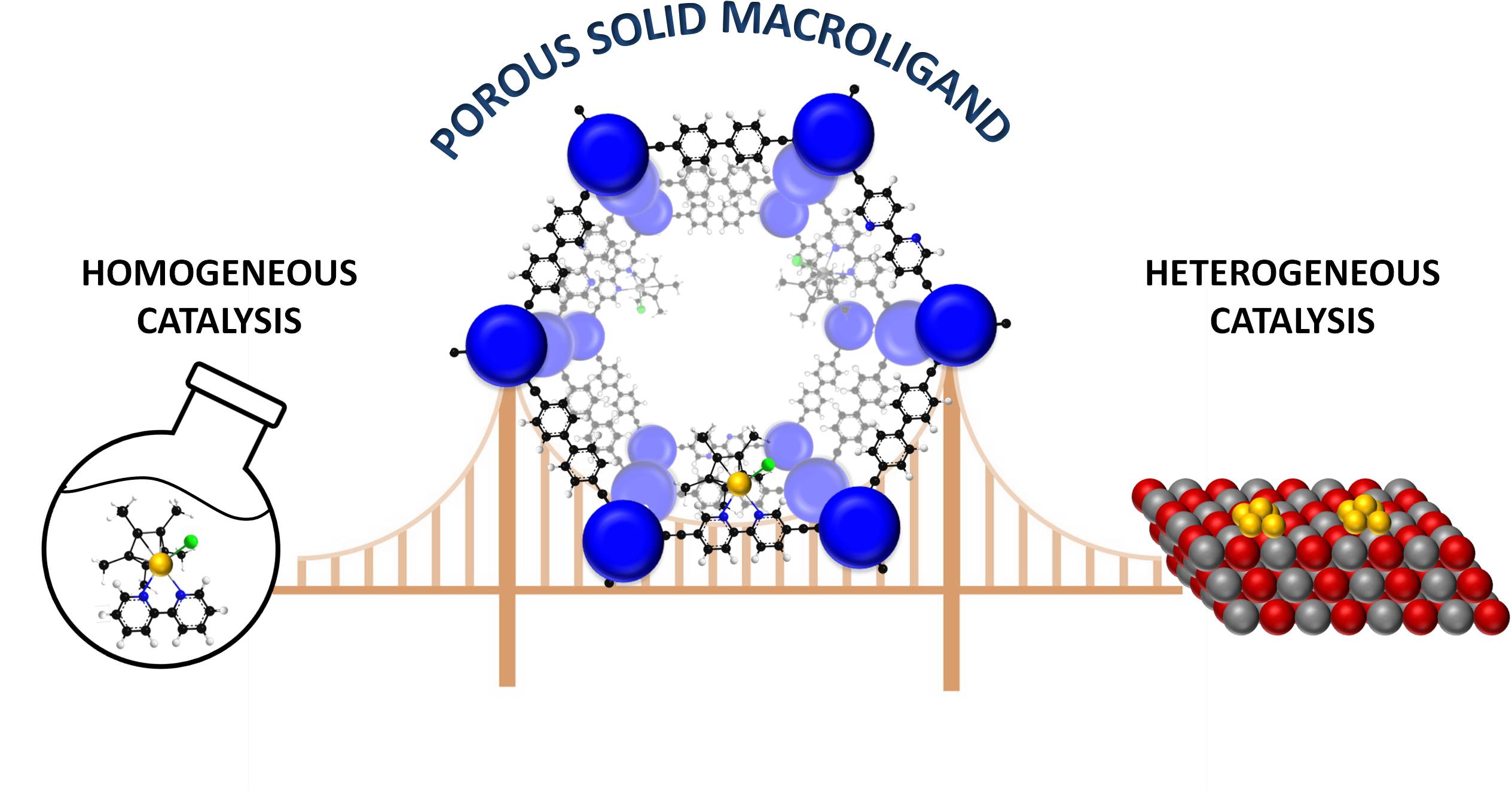
Molecular Catalysts Confined inside Cavities: The Concept of Solid Porous Macroligands
Thanks to their hybrid formulation, Metal-Organic Frameworks (MOF) shall bridge the gap between pure inorganic and organic materials, thereby pushing the frontiers of knowledge ever further. Initially, MOFs were regarded only as a new type of molecular sieve material with a pore size between those of inorganic zeolites (<1 nm) and ordered mesoporous silica materials (>2 nm). On the other hand, their stimuli-induced flexibility, or more generally their softness, is common trait with organic enzymes. Novel porous platforms allows adressing new challenges in heterogeneous catalysis whicle tackling issues on stability and control over active site: Covalent Organic Frameworks (COF) and Conjugated Microporous Polymers (CMP).
From MOF to COF and CMP, they present decreasing ordered structure and control over the porosity but increasing chemical stability.
They thus appear as very appealing platforms and their use as macroligands for the heterogenization of molecular catalysts is further reducing the gap between homogeneous and heterogeneous catalysis.
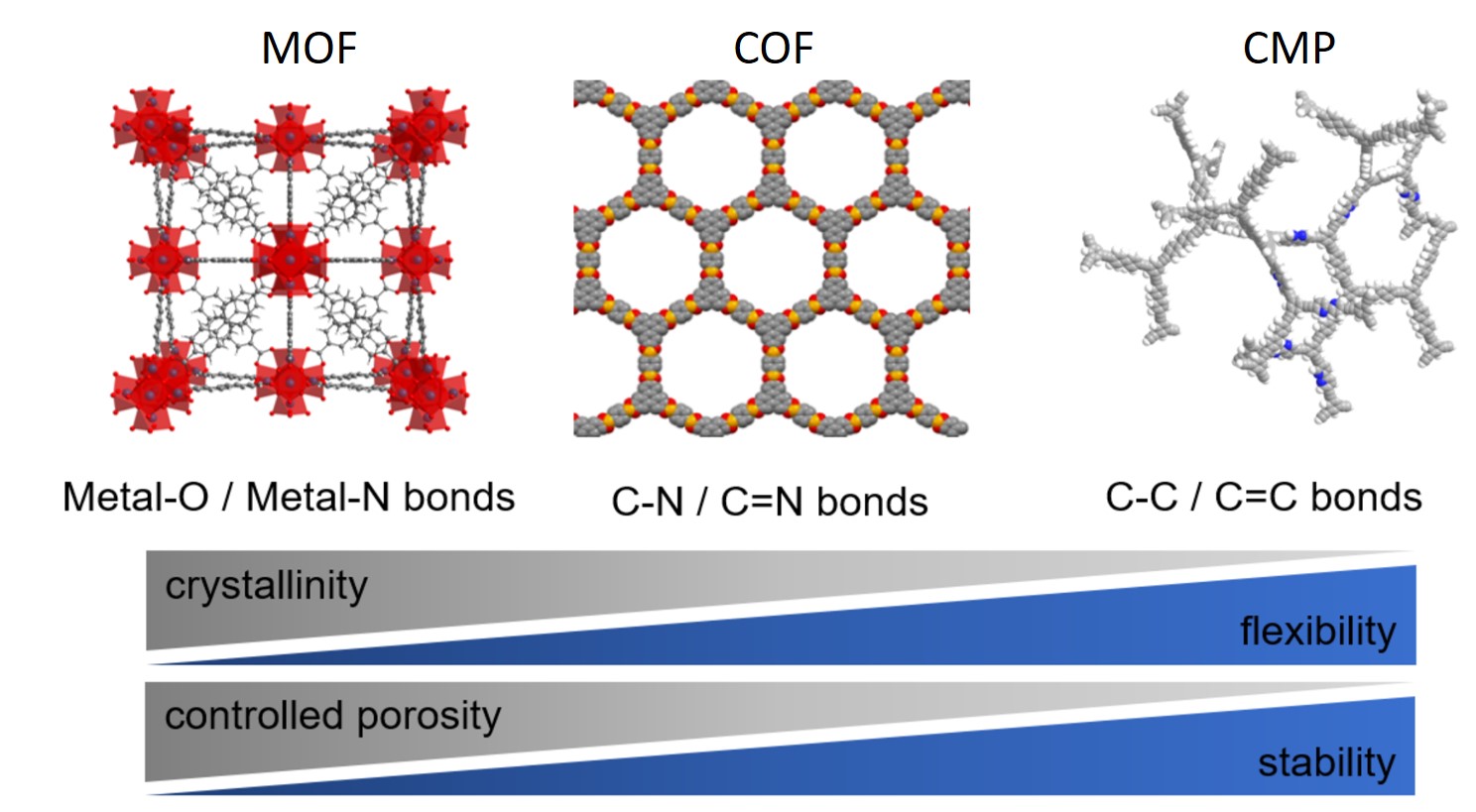
Research topics range from C-C coupling to asymmetry, photocatalysis and green fuels.
---- Funding scheme: national and international collaborative projects ----
Jérôme Canivet further aims at exploiting the confinement of molecular catalytic systems into porous structures for the improvement of their catalytic activity and selectivity, and he is coordinating cooperative projects on this topic.
-> Coordinator of the ANR PoMAc project (2018-2022, 42+6 months, 385 k€)
"Confinement of peptide sequences in Porous Macroligand for Asymmetric Catalysis"
(noble metal-based chiral porous catalysts) TRL3
-> WP leader - partner scientific coordinator of the H2020 H-CCAT project (2017-2021, 48+6 months, 12 partners, 7.6 M€) http://h-ccat.eu/
"Solid Catalysts for activation of aromatic C-H bonds"
(hybrid heterogeneous catalysts for C-H arylation) TRL3 -> TRL5
-> Partner of the ANR FLiPs project (2021-2025, 48 months, 430 k€)
"Frustrated Lewis Pairs Catalysts inside Molecularly Defined Porous Solid Matrix"
(FLP@MOF and POP for catalytic reduction reactions) TRL2/3
-> Partner of the H2020 C123 project (2019-2023, 48 months, 13 partners, 6.3 M€)
"Methane oxidative conversion and hydroformylation to propylen"
(hybrid heterogeneous catalysts for hydroformylation) TRL3 -> TRL5
-> Partner of the ANR Cat2Cat project (2016-2020, 42+6 months, 575 k€)
"From catalysts to cathodes: a controlled-architecture approach for PEMFC electrodes catalyzed by Earth-abundant metals"
(doped-MOF precursors to catalytic carbon electrodes) TRL3/4
---------- MOF Team members ---------------
CNRS Researchers
Dr. Elsje Alessandra Quadrelli : co-supervision of PhD students, projects support
Green Chemistry and Sustainable Energy
PhD students
Anissa Yacin Ali (started 01/2025) – Novel photo-electrocatalysts for the CO2 conversion (ANR - PEPR)
Emilien Chaigne--Tarlottin (started 11/2023) – Light-harvesting Porous Macroligands (ANR - PEPR)
Riddhi Kumari 01/2022 – 03/2025, Heterogenization of molecular active sites within MOF and POP for CO2 reduction and fine chemical synthesis (ANR)
Alisa Ranscht, 09/2020 – 02/2024, Cationic porous organic polymers for the immobilization of polyoxometallates (Indust. Funding)
Baptiste Chauchon, 10/2018 – 09/2021, Porous catalysts for asymmetric transfer hydrogenation (ANR)
Remy Rajapaksha, 10/2018 – 03/2022, Porous catalysts for alkenes oligomerization (Univ. Lyon grant)
Hua Wei,11/2017 – 03/2021, Innovative electrodes for the catalytic activation of small molecules (SINCHEM program)
Clement Demarcy, 02/2017 – 10/2020, Synthesis of homogeneous and supported Pd(NHC) catalysts for the selective arylation of indole at the C-3 position (H2020 program, Univ. Lyon 1)
Marcelo Alves-Favaro, 05/2017 – 05/2020, Synthesis of new Covalent Triazine Frameworks for Carbon Dioxide Photoreduction (EU-SINCHEM program, Univ. Lyon 1 – RWTH Aachen)
Yorck Mohr, 02/2017 – 04/2020, From Molecular Catalysts to their Incorporation in Porous Materials: The Case of Regiospecific Aromatic CH Arylation (H2020 program, Univ. Lyon 1)
Jonathan Bonnefoy, 10/2012 – 10/2015, Conception of new bio-inspired MOF-based hybrid materials with advanced functionalities for catalysis (ANR program, Univ. Lyon 1)
Postdoctoral collaborators
Dr. R. Newar Feb. 2023 – Sept. 2023 (internal funding)
Dr. P. Samanta Nov. 2020 – Dec. 2022 (H2020)
Dr. M. Alves-Favaro May. 2020 – Feb. 2021 (H2020)
Dr. A. Ghosh Sept. 2019 – Dec. 2021 (CNRS)
Dr. Y. Roux Jun. 2018 – May. 2020 (H2020)
Dr. K. Barbera Jan. 2017 – Jan. 2019 (ANR)
Dr. E. Bernoud Sept. 2016 – Sept. 2017 (Univ. Lyon)
Dr. F. M. Wisser Apr. 2016 – Jan. 2020 (DFG grant, Germany; CNRS)
Dr. M. Vandichel Jun. 2015 – Dec.2015 (invited researcher from UGhent, Belgium)
Dr. A. Legrand Oct. 2013 – Jan.2016 (ANR)
Non-permanent research staff
2020 G. Hisler (research engineer)
Undergraduate students
2023 A. Gouge (Univ. Montpellier)
2023 C. NGuessan (UCBL)
2022 M. Häger (Uni. Leipzig)
2021 C. Got (CPE Lyon)
2020 P. Bredy (CPE Lyon)
2019 A. Ranscht (Uni. Leipzig)
2019 L. Grousset (Univ. Montpellier)
2018 F. Tamisier (Univ. Grenoble)
2017 S. Abou-derhamine (Univ. Lyon)
2017 M. Balas (CPE Lyon)
2016 M. Tripathi (Univ. Grenoble)
2016 H. Hussein (Univ. Lyon)
2015 A. Valette (UPMC, Paris)
2015 B. Mortada (Univ. Lyon)
2014 S. Leinardi (Univ. Lyon)
2013 A. Molino (Univ. Torino)
Follow us on Twitter MOF@IRCELYON
MOF Team 2020
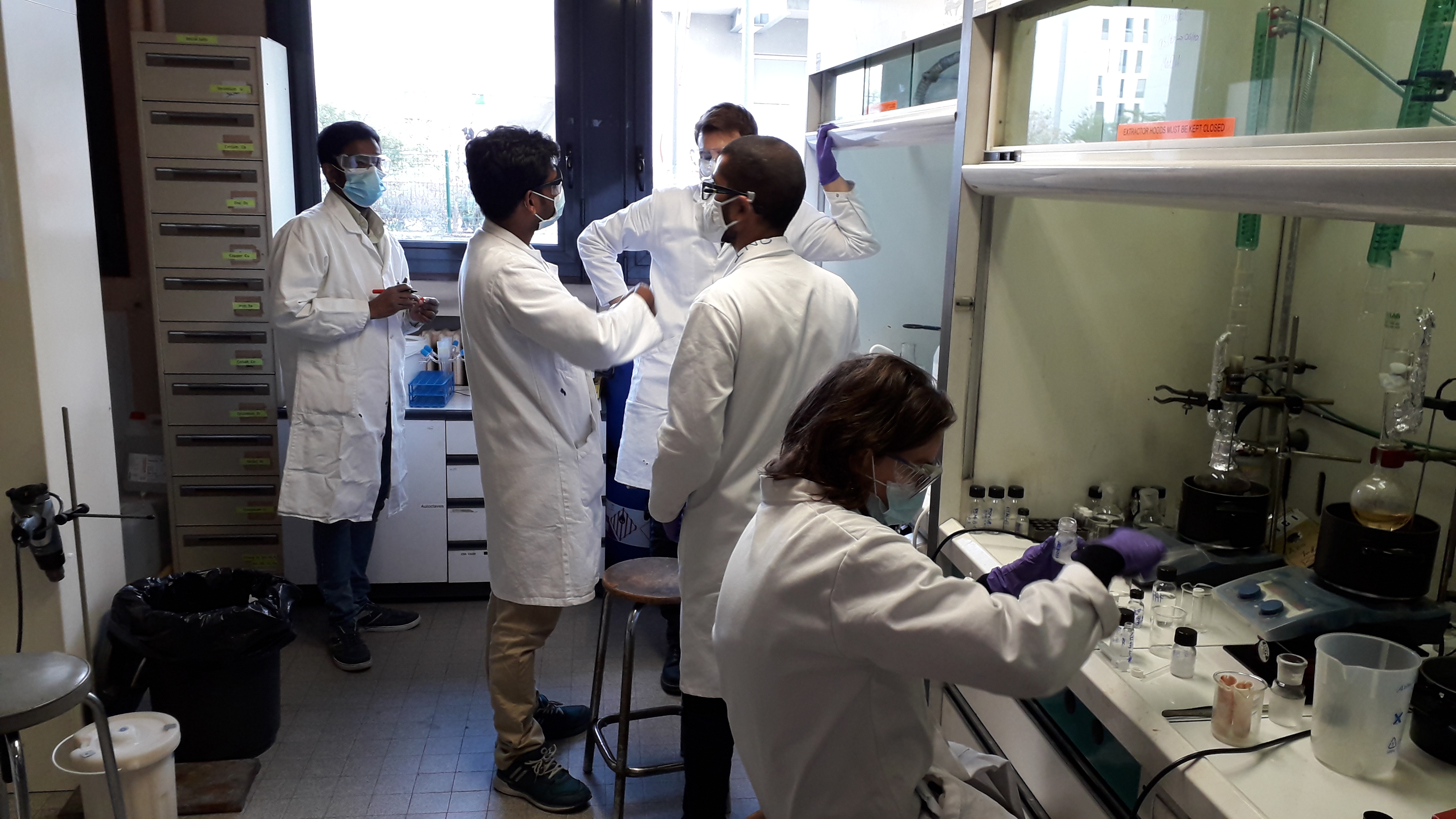
A. Ghosh - P. Samanta - M. Alves-Favaro - R. Rajapaksha - A. Ranscht
MOF Team 2018
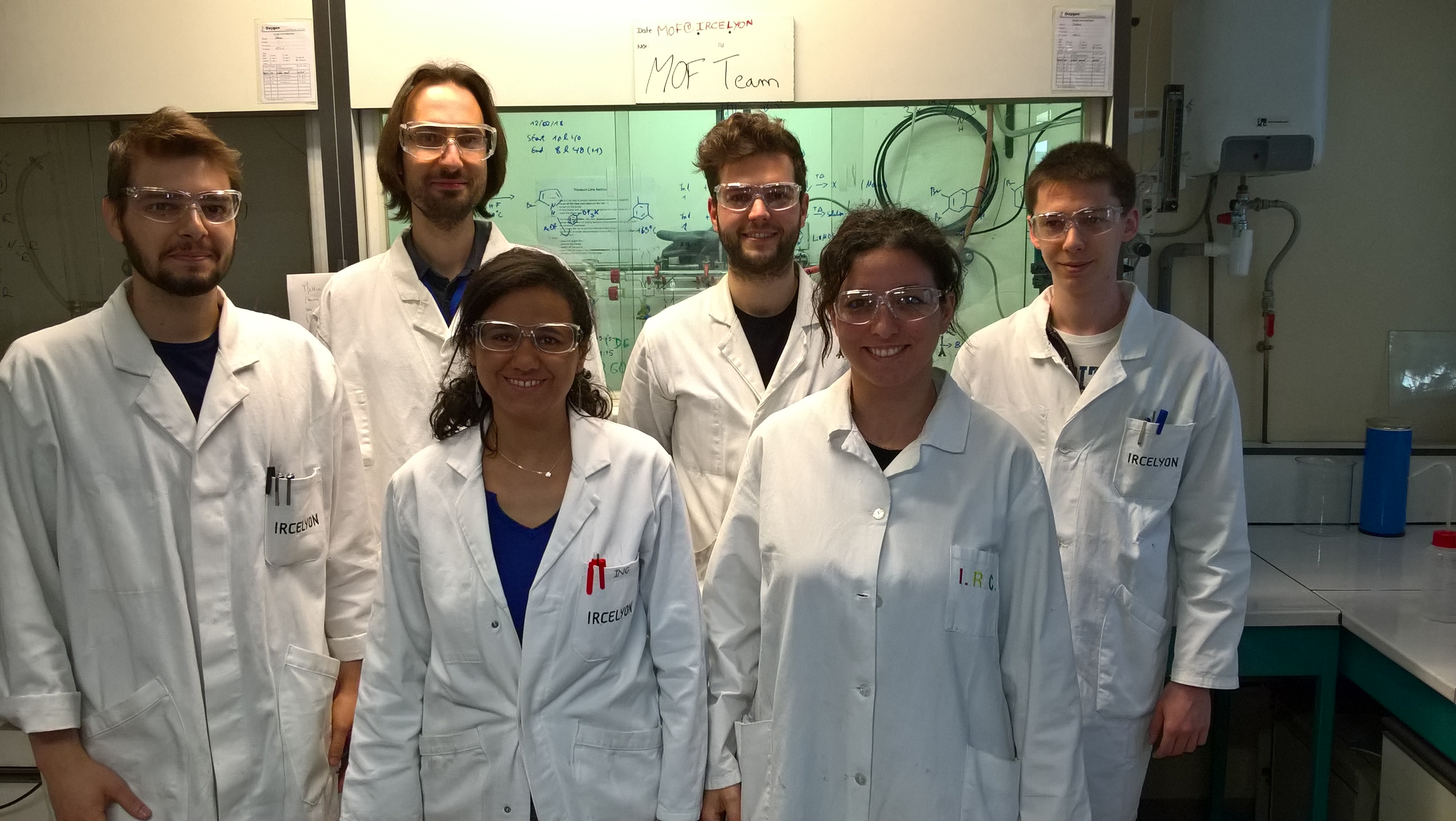
M. Alves-Favaro - F. M. Wisser - Y. Khabzina - Y. Mohr - K. Barbera - F. Tamisier
Heterogenization of Active Molecular Catalysts for Enhanced Productivity, Selectivity and Sustainability
ChemCatChem 2020, 12, 1270-1275
For Photocatalysis and Solar Fuels
International Research Project: Small Molecules Laboratory
!!...Watch Smolab video here...!!
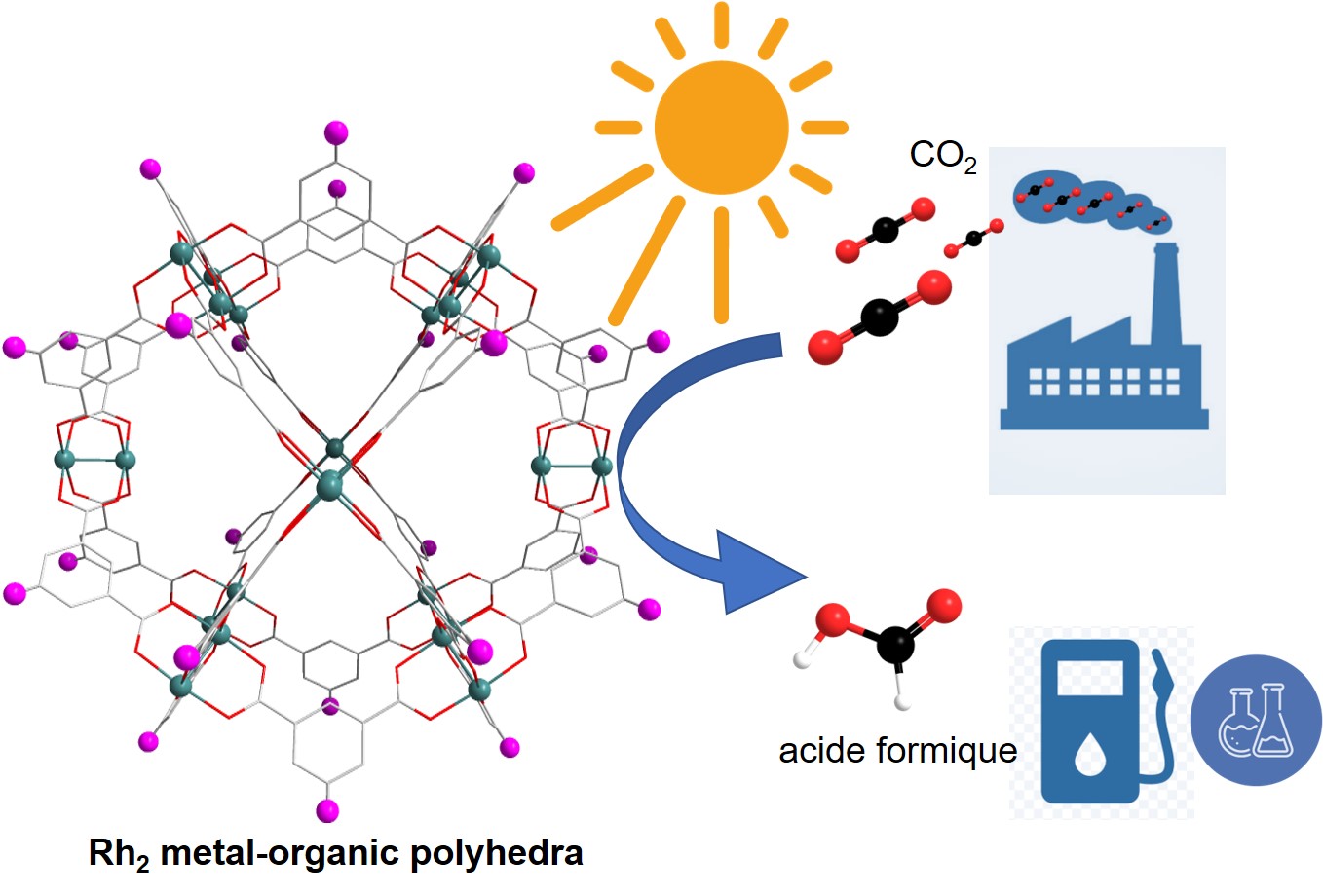
see J. Am. Chem. Soc. 2022, 144, 3626-3636
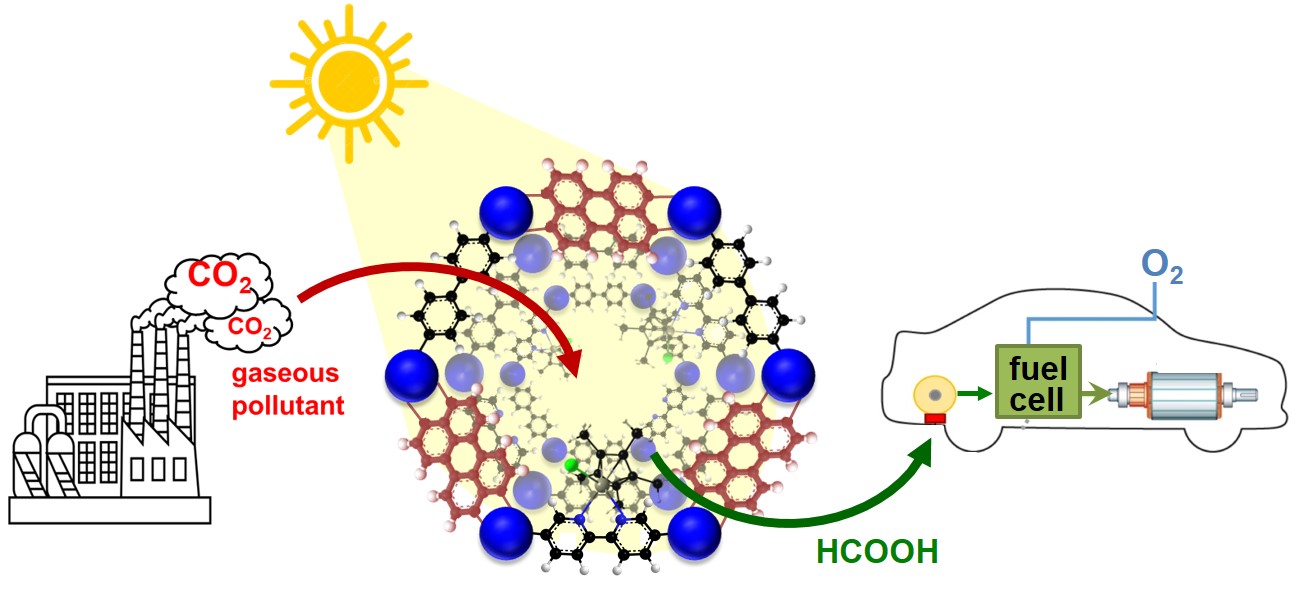
see ACS Catal. 2018, 8, 1653-1661
Angew. Chem. Int. Ed. 2020, 59, 5116-5122
For Sustainable Birayl Synthesis for Drug and Optoelectronics
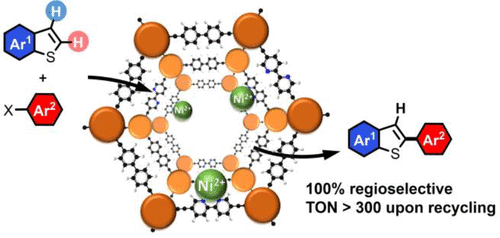
see Green.Chem. 2020, 22, 3155-3161
ACS Catal. 2021, 11, 3507-3515
For Sustainable Asymmetric Catalysis
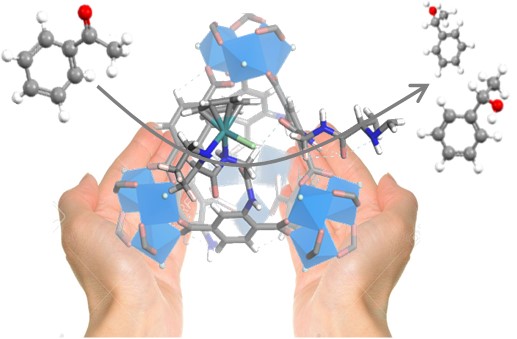
see J. Am. Chem. Soc. 2015, 137, 9409-9416
Chem. Sci. 2020, 11, 8800-8808
For Understanding Host-Guest interactions using DFT combined with DNP-SENS
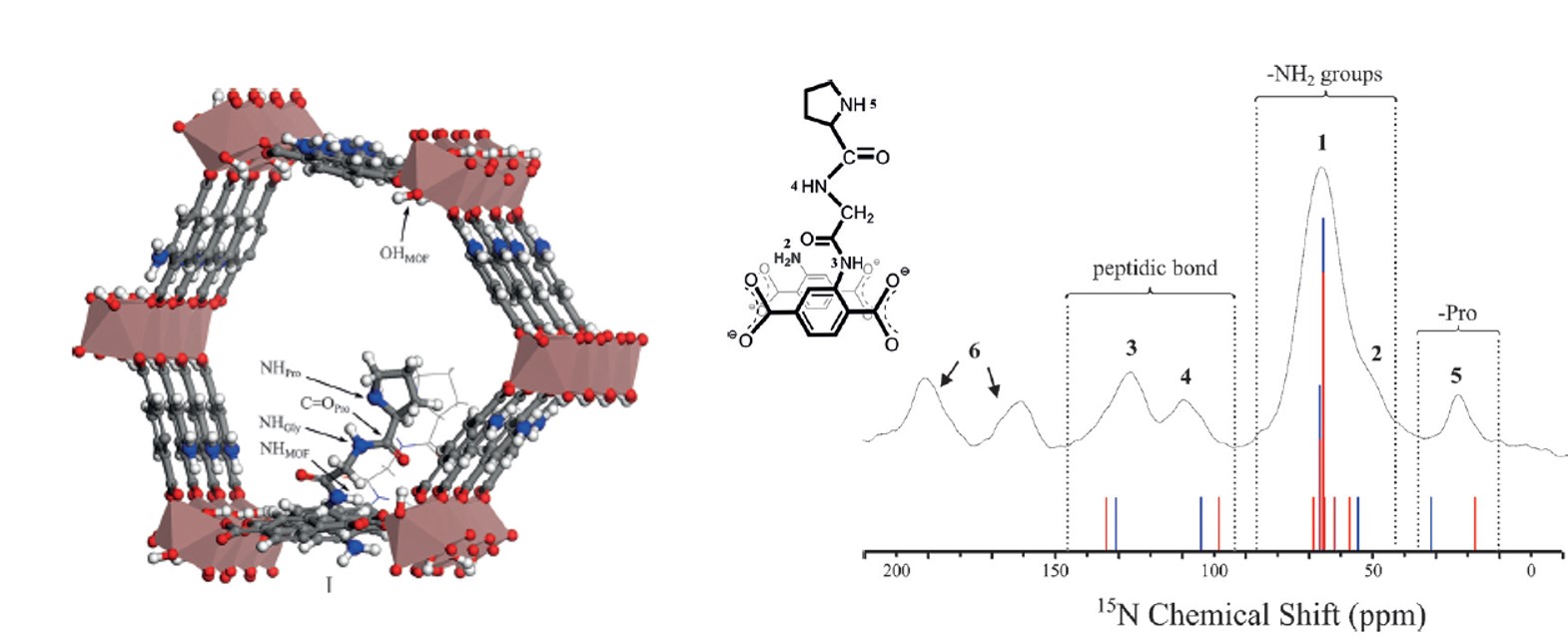
see Chem.Eur.J. 2016, 46, 16531-16538
For Ethylene Valorization Processes
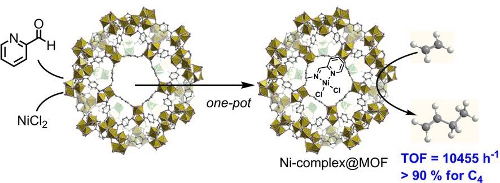
see J. Am. Chem. Soc. 2013, 135, 4195-4198
PhD supervision/direction and evaluator here
Advanced lectures for graduated students
2019: ITbm/GTR Seminar Series, Nagoya, Japan
Heterogenized molecular catalysis: Unifying two world
2019: Elicat Summer School on Catalysis, Villeurbanne, France
Application of Metal-Organic Frameworks to Catalysis
2017: Elicat Summer School on Catalysis, Villeurbanne, France
Metal-Organic Frameworks: Extended Molecular Networks vs. Surface Science
2014: IGER/ITbM/RCMS Seminar Series, Nagoya, Japan
Metal-Organic Frameworks: A new tale of the Emperor's new clothes
Perrinet Q., Ghosh A.,  Jerome Canivet Chercheur 445 424 (Standard + 33 [0] 472 445 300) P105 Canivet J., Wisser F., Roland T., De Waele V.
Jerome Canivet Chercheur 445 424 (Standard + 33 [0] 472 445 300) P105 Canivet J., Wisser F., Roland T., De Waele V.
JOURNAL OF PHYSICAL CHEMISTRY C, 2025, p.
Beucher R., Lacote E.,  Jerome Canivet Chercheur 445 424 (Standard + 33 [0] 472 445 300) P105 Canivet J.,
Jerome Canivet Chercheur 445 424 (Standard + 33 [0] 472 445 300) P105 Canivet J.,  David Farrusseng Chercheur 445 365 (Standard + 33 [0] 472 445 300) P109 Farrusseng D.
David Farrusseng Chercheur 445 365 (Standard + 33 [0] 472 445 300) P109 Farrusseng D.
NEW JOURNAL OF CHEMISTRY, 2024, p.
Riddhi R., Penas-Hidalgo F., Chen H.,  Elsje Alessandra Quadrelli Chercheur 445 359 (Standard + 33 [0] 472 445 300) P114 Quadrelli E. A.,
Elsje Alessandra Quadrelli Chercheur 445 359 (Standard + 33 [0] 472 445 300) P114 Quadrelli E. A.,  Jerome Canivet Chercheur 445 424 (Standard + 33 [0] 472 445 300) P105 Canivet J., Mellot-Draznieks C., Sole-Daura A.
Jerome Canivet Chercheur 445 424 (Standard + 33 [0] 472 445 300) P105 Canivet J., Mellot-Draznieks C., Sole-Daura A.
CHEMICAL SOCIETY REVIEWS, 2024, p.
Ranscht A., Rigodanza F., Gobbato T., Crea I.,  Elsje Alessandra Quadrelli Chercheur 445 359 (Standard + 33 [0] 472 445 300) P114 Quadrelli E. A.,
Elsje Alessandra Quadrelli Chercheur 445 359 (Standard + 33 [0] 472 445 300) P114 Quadrelli E. A.,  Jerome Canivet Chercheur 445 424 (Standard + 33 [0] 472 445 300) P105 Canivet J., Bonchio M.
Jerome Canivet Chercheur 445 424 (Standard + 33 [0] 472 445 300) P105 Canivet J., Bonchio M.
CHEMISTRY-A EUROPEAN JOURNAL, 2024, p.
Samanta P.,  Jerome Canivet Chercheur 445 424 (Standard + 33 [0] 472 445 300) P105 Canivet J.
Jerome Canivet Chercheur 445 424 (Standard + 33 [0] 472 445 300) P105 Canivet J.
MOF-Supported Heterogeneous Catalysts for Hydroformylation Reactions: A Minireview
CHEMCATCHEM, 2024, p.
Newar R., Ghosh A., Riddhi R., Rajapaksha R., Samanta P., Wisser F.,  Jerome Canivet Chercheur 445 424 (Standard + 33 [0] 472 445 300) P105 Canivet J.
Jerome Canivet Chercheur 445 424 (Standard + 33 [0] 472 445 300) P105 Canivet J.
ADVANCED ENERGY AND SUSTAINABILITY RESEARCH, 2023, p.
Samanta P., Beucher R., Riddhi R., Ranscht A., Wisser F.,  Elsje Alessandra Quadrelli Chercheur 445 359 (Standard + 33 [0] 472 445 300) P114 Quadrelli E. A.,
Elsje Alessandra Quadrelli Chercheur 445 359 (Standard + 33 [0] 472 445 300) P114 Quadrelli E. A.,  Jerome Canivet Chercheur 445 424 (Standard + 33 [0] 472 445 300) P105 Canivet J.
Jerome Canivet Chercheur 445 424 (Standard + 33 [0] 472 445 300) P105 Canivet J.
CATALYSIS SCIENCE & TECHNOLOGY, 2023, 13(20), pp. 5825-5830
Rajapaksha R., Samanta P.,  Elsje Alessandra Quadrelli Chercheur 445 359 (Standard + 33 [0] 472 445 300) P114 Quadrelli E. A.,
Elsje Alessandra Quadrelli Chercheur 445 359 (Standard + 33 [0] 472 445 300) P114 Quadrelli E. A.,  Jerome Canivet Chercheur 445 424 (Standard + 33 [0] 472 445 300) P105 Canivet J.
Jerome Canivet Chercheur 445 424 (Standard + 33 [0] 472 445 300) P105 Canivet J.
CHEMICAL SOCIETY REVIEWS, 2023, p.
Jabbour R., Ashling C., Robinson T., Khan A., Wisser D., Berruyer P., Ghosh A., Ranscht A., Keen D., Brunner E.,  Jerome Canivet Chercheur 445 424 (Standard + 33 [0] 472 445 300) P105 Canivet J., Bennett T., Mellot-Draznieks C., Lesage A., Wisser F.
Jerome Canivet Chercheur 445 424 (Standard + 33 [0] 472 445 300) P105 Canivet J., Bennett T., Mellot-Draznieks C., Lesage A., Wisser F.
ANGEWANDTE CHEMIE-INTERNATIONAL EDITION, 2023, p.
Favaro M., Yang J., Ditz D., Kucukkececi H., Alkhurisi M., Bergwinkl S., Thomas A.,  Elsje Alessandra Quadrelli Chercheur 445 359 (Standard + 33 [0] 472 445 300) P114 Quadrelli E. A., Palkovits R.,
Elsje Alessandra Quadrelli Chercheur 445 359 (Standard + 33 [0] 472 445 300) P114 Quadrelli E. A., Palkovits R.,  Jerome Canivet Chercheur 445 424 (Standard + 33 [0] 472 445 300) P105 Canivet J., Wisser F.
Jerome Canivet Chercheur 445 424 (Standard + 33 [0] 472 445 300) P105 Canivet J., Wisser F.
CHEMCATCHEM, 2023, p.
 Jerome Canivet Chercheur 445 424 (Standard + 33 [0] 472 445 300) P105 Canivet J., Wisser F.
Jerome Canivet Chercheur 445 424 (Standard + 33 [0] 472 445 300) P105 Canivet J., Wisser F.
ACS APPLIED ENERGY MATERIALS, 2023, p.
Perrot V., Roussey A., Benayad A., Veillerot M., Mariolle D., Sole-Daura A., Mellot-Draznieks C., Ricoul F.,  Jerome Canivet Chercheur 445 424 (Standard + 33 [0] 472 445 300) P105 Canivet J.,
Jerome Canivet Chercheur 445 424 (Standard + 33 [0] 472 445 300) P105 Canivet J.,  Elsje Alessandra Quadrelli Chercheur 445 359 (Standard + 33 [0] 472 445 300) P114 Quadrelli E. A., Jousseaume V.
Elsje Alessandra Quadrelli Chercheur 445 359 (Standard + 33 [0] 472 445 300) P114 Quadrelli E. A., Jousseaume V.
ZIF-8 thin films by a vapor-phase process: limits to growth
NANOSCALE, 2023, p.
Samanta P., Sole-Daura A., Rajapaksha R., Wisser F.,  Frederic Meunier Chercheur 445 468 (Standard + 33 [0] 472 445 300) C13.009 Meunier F.,
Frederic Meunier Chercheur 445 468 (Standard + 33 [0] 472 445 300) C13.009 Meunier F.,  Yves Schuurman Chercheur 445 482 (Standard + 33 [0] 472 445 300) P129 Schuurman Y., Sassoye C., Mellot-Draznieks C.,
Yves Schuurman Chercheur 445 482 (Standard + 33 [0] 472 445 300) P129 Schuurman Y., Sassoye C., Mellot-Draznieks C.,  Jerome Canivet Chercheur 445 424 (Standard + 33 [0] 472 445 300) P105 Canivet J.
Jerome Canivet Chercheur 445 424 (Standard + 33 [0] 472 445 300) P105 Canivet J.
ACS CATALYSIS, 2023, pp. 4193-4204
Mohr Y., Ranscht A., Alves-Favaro M.,  Elsje Alessandra Quadrelli Chercheur 445 359 (Standard + 33 [0] 472 445 300) P114 Quadrelli E. A., Wisser F.,
Elsje Alessandra Quadrelli Chercheur 445 359 (Standard + 33 [0] 472 445 300) P114 Quadrelli E. A., Wisser F.,  Jerome Canivet Chercheur 445 424 (Standard + 33 [0] 472 445 300) P105 Canivet J.
Jerome Canivet Chercheur 445 424 (Standard + 33 [0] 472 445 300) P105 Canivet J.
CHEMISTRY-A EUROPEAN JOURNAL, 2022, p.
Henrion M., Mohr Y., Janssens K., Smolders S., Bugaev A., Usoltsev O.,  Elsje Alessandra Quadrelli Chercheur 445 359 (Standard + 33 [0] 472 445 300) P114 Quadrelli E. A., Wisser F., De Vos D.,
Elsje Alessandra Quadrelli Chercheur 445 359 (Standard + 33 [0] 472 445 300) P114 Quadrelli E. A., Wisser F., De Vos D.,  Jerome Canivet Chercheur 445 424 (Standard + 33 [0] 472 445 300) P105 Canivet J.
Jerome Canivet Chercheur 445 424 (Standard + 33 [0] 472 445 300) P105 Canivet J.
CHEMCATCHEM, 2022, p.
Favaro M., Ditz D., Yang J., Bergwinkl S., Ghosh A., Stammler M.,  Chantal Lorentz Personnel technique et administratif 445 339 (Standard + 33 [0] 472 445 300) P206 Lorentz C., Roeser J.,
Chantal Lorentz Personnel technique et administratif 445 339 (Standard + 33 [0] 472 445 300) P206 Lorentz C., Roeser J.,  Elsje Alessandra Quadrelli Chercheur 445 359 (Standard + 33 [0] 472 445 300) P114 Quadrelli E. A., Thomas A., Palkovits R.,
Elsje Alessandra Quadrelli Chercheur 445 359 (Standard + 33 [0] 472 445 300) P114 Quadrelli E. A., Thomas A., Palkovits R.,  Jerome Canivet Chercheur 445 424 (Standard + 33 [0] 472 445 300) P105 Canivet J., Wisser F.
Jerome Canivet Chercheur 445 424 (Standard + 33 [0] 472 445 300) P105 Canivet J., Wisser F.
Finding the Sweet Spot of Photocatalysis-A Case Study Using Bipyridine-Based CTFs
ACS APPLIED MATERIALS & INTERFACES, 2022, 14(12), pp. 14182-14192
Ghosh A., Legrand A., Rajapaksha R., Craig G., Sassoye C., Balazs G.,  David Farrusseng Chercheur 445 365 (Standard + 33 [0] 472 445 300) P109 Farrusseng D., Furukawa S.,
David Farrusseng Chercheur 445 365 (Standard + 33 [0] 472 445 300) P109 Farrusseng D., Furukawa S.,  Jerome Canivet Chercheur 445 424 (Standard + 33 [0] 472 445 300) P105 Canivet J., Wisser F.
Jerome Canivet Chercheur 445 424 (Standard + 33 [0] 472 445 300) P105 Canivet J., Wisser F.
Rhodium-Based Metal-Organic Polyhedra Assemblies for Selective CO2 Photoreduction
JOURNAL OF THE AMERICAN CHEMICAL SOCIETY, 2022, 144(8), pp. 3626-3636
Fonseca A., Heyn R., Froseth M., Thybaut J., Poissonnier J., Meiswinkel A., Zander H.,  Jerome Canivet Chercheur 445 424 (Standard + 33 [0] 472 445 300) P105 Canivet J.
Jerome Canivet Chercheur 445 424 (Standard + 33 [0] 472 445 300) P105 Canivet J.
JOHNSON MATTHEY TECHNOLOGY REVIEW, 2021, 65(2), pp. 311-329
Mohr Y., Alves-Favaro M., Rajapaksha R., Hisler G., Ranscht A., Samanta P.,  Chantal Lorentz Personnel technique et administratif 445 339 (Standard + 33 [0] 472 445 300) P206 Lorentz C., Duguet M., Mellot-Draznieks C.,
Chantal Lorentz Personnel technique et administratif 445 339 (Standard + 33 [0] 472 445 300) P206 Lorentz C., Duguet M., Mellot-Draznieks C.,  Elsje Alessandra Quadrelli Chercheur 445 359 (Standard + 33 [0] 472 445 300) P114 Quadrelli E. A., Wisser F.,
Elsje Alessandra Quadrelli Chercheur 445 359 (Standard + 33 [0] 472 445 300) P114 Quadrelli E. A., Wisser F.,  Jerome Canivet Chercheur 445 424 (Standard + 33 [0] 472 445 300) P105 Canivet J.
Jerome Canivet Chercheur 445 424 (Standard + 33 [0] 472 445 300) P105 Canivet J.
ACS CATALYSIS, 2021, 11(6), pp. 3507-3515
 Jerome Canivet Chercheur 445 424 (Standard + 33 [0] 472 445 300) P105 Canivet J., Bernoud E., Bonnefoy J., Legrand A., Todorova T.,
Jerome Canivet Chercheur 445 424 (Standard + 33 [0] 472 445 300) P105 Canivet J., Bernoud E., Bonnefoy J., Legrand A., Todorova T.,  Elsje Alessandra Quadrelli Chercheur 445 359 (Standard + 33 [0] 472 445 300) P114 Quadrelli E. A., Mellot-Draznieks C.
Elsje Alessandra Quadrelli Chercheur 445 359 (Standard + 33 [0] 472 445 300) P114 Quadrelli E. A., Mellot-Draznieks C.
Chemical science, 2020, 11, pp. 8800-8808
Wisser F., Duguet M., Perrinet Q., Ghosh A., Alves-Favaro M., Mohr Y.,  Chantal Lorentz Personnel technique et administratif 445 339 (Standard + 33 [0] 472 445 300) P206 Lorentz C., Quadrelli E., Palkovits R.,
Chantal Lorentz Personnel technique et administratif 445 339 (Standard + 33 [0] 472 445 300) P206 Lorentz C., Quadrelli E., Palkovits R.,  David Farrusseng Chercheur 445 365 (Standard + 33 [0] 472 445 300) P109 Farrusseng D., Mellot-Draznieks C., De Waele V.,
David Farrusseng Chercheur 445 365 (Standard + 33 [0] 472 445 300) P109 Farrusseng D., Mellot-Draznieks C., De Waele V.,  Jerome Canivet Chercheur 445 424 (Standard + 33 [0] 472 445 300) P105 Canivet J.
Jerome Canivet Chercheur 445 424 (Standard + 33 [0] 472 445 300) P105 Canivet J.
Molecular Porous Photosystems Tailored for Long-Term Photocatalytic CO2 Reduction
Angewandte chemie-international edition, 2020, 59, pp. 5116-5122
Mohr Y., Hisler G., Grousset L., Roux Y., Quadrelli E., Wisser F.,  Jerome Canivet Chercheur 445 424 (Standard + 33 [0] 472 445 300) P105 Canivet J.
Jerome Canivet Chercheur 445 424 (Standard + 33 [0] 472 445 300) P105 Canivet J.
Nickel-catalyzed and Li-mediated regiospecific C-H arylation of benzothiophenes
Green chemistry, 2020, 22, pp. 3155-3161
Mohr Y., Renom-Carrasco M., Demarcy C., Quadrelli E., Camp C., Wisser F., Clot E., Thieuleux C.,  Jerome Canivet Chercheur 445 424 (Standard + 33 [0] 472 445 300) P105 Canivet J.
Jerome Canivet Chercheur 445 424 (Standard + 33 [0] 472 445 300) P105 Canivet J.
Acs catalysis, 2020, 10, pp. 2713-2719
Wisser F., Mohr Y., Quadrelli E.,  Jerome Canivet Chercheur 445 424 (Standard + 33 [0] 472 445 300) P105 Canivet J.
Jerome Canivet Chercheur 445 424 (Standard + 33 [0] 472 445 300) P105 Canivet J.
Porous Macroligands: Materials for Heterogeneous Molecular Catalysis
Chemcatchem, 2020, 5, pp. 1270-1275
Wang X., Wisser F.,  Jerome Canivet Chercheur 445 424 (Standard + 33 [0] 472 445 300) P105 Canivet J., Fontecave M., Mellot-Draznieks C.
Jerome Canivet Chercheur 445 424 (Standard + 33 [0] 472 445 300) P105 Canivet J., Fontecave M., Mellot-Draznieks C.
Chemsuschem, 2018, 11, pp. 3315-3322
Wisser F., Mohr Y., Quadrelli E.,  David Farrusseng Chercheur 445 365 (Standard + 33 [0] 472 445 300) P109 Farrusseng D.,
David Farrusseng Chercheur 445 365 (Standard + 33 [0] 472 445 300) P109 Farrusseng D.,  Jerome Canivet Chercheur 445 424 (Standard + 33 [0] 472 445 300) P105 Canivet J.
Jerome Canivet Chercheur 445 424 (Standard + 33 [0] 472 445 300) P105 Canivet J.
Chemcatchem, 2018, 10, pp. 1778-1782
Wisser F., Berruyer P.,  Luis Cardenas Chercheur 445 314 (Standard + 33 [0] 472 445 300) P205 Cardenas L., Mohr Y., Quadrelli E., Lesage A.,
Luis Cardenas Chercheur 445 314 (Standard + 33 [0] 472 445 300) P205 Cardenas L., Mohr Y., Quadrelli E., Lesage A.,  David Farrusseng Chercheur 445 365 (Standard + 33 [0] 472 445 300) P109 Farrusseng D.,
David Farrusseng Chercheur 445 365 (Standard + 33 [0] 472 445 300) P109 Farrusseng D.,  Jerome Canivet Chercheur 445 424 (Standard + 33 [0] 472 445 300) P105 Canivet J.
Jerome Canivet Chercheur 445 424 (Standard + 33 [0] 472 445 300) P105 Canivet J.
Hammett Parameter in Microporous Solids as Macroligands for Heterogenized Photocatalysts
Acs catalysis, 2018, 8, pp. 1653-1661
Robin J., Audebrand N., Poriel C.,  Jerome Canivet Chercheur 445 424 (Standard + 33 [0] 472 445 300) P105 Canivet J., Calvez G., Roisnel T., Dorcet V., Roussel P.
Jerome Canivet Chercheur 445 424 (Standard + 33 [0] 472 445 300) P105 Canivet J., Calvez G., Roisnel T., Dorcet V., Roussel P.
Crystengcomm, 2017, 19, pp. 2042-2056
Marepally B, Ampelli C, Genovese C, Saboo T, Perathoner S, Wisser F, Veyre L,  Jerome Canivet Chercheur 445 424 (Standard + 33 [0] 472 445 300) P105 Canivet J., Quadrelli E, Centi G
Jerome Canivet Chercheur 445 424 (Standard + 33 [0] 472 445 300) P105 Canivet J., Quadrelli E, Centi G
Chemsuschem, 2017, 10, pp. 4442-4446
 Jerome Canivet Chercheur 445 424 (Standard + 33 [0] 472 445 300) P105 Canivet J., Lysenko V, Lehtinen J, Legrand A, Wisser F, Quadrelli E,
Jerome Canivet Chercheur 445 424 (Standard + 33 [0] 472 445 300) P105 Canivet J., Lysenko V, Lehtinen J, Legrand A, Wisser F, Quadrelli E,  David Farrusseng Chercheur 445 365 (Standard + 33 [0] 472 445 300) P109 Farrusseng D.
David Farrusseng Chercheur 445 365 (Standard + 33 [0] 472 445 300) P109 Farrusseng D.
Chemphyschem, 2017, 18, pp. 2855-2858
Dhainaut J., Avci-Camur C., Troyano J., Legrand A.,  Jerome Canivet Chercheur 445 424 (Standard + 33 [0] 472 445 300) P105 Canivet J., Imaz I., Maspoch D., Reinsch H.,
Jerome Canivet Chercheur 445 424 (Standard + 33 [0] 472 445 300) P105 Canivet J., Imaz I., Maspoch D., Reinsch H.,  David Farrusseng Chercheur 445 365 (Standard + 33 [0] 472 445 300) P109 Farrusseng D.
David Farrusseng Chercheur 445 365 (Standard + 33 [0] 472 445 300) P109 Farrusseng D.
CrystEngComm, 2017, 19, pp. 4211-4218
Todorova T. K., Rozanska X., Gervais C., Legrand A., Ho L. N., Berruyer P., Lesage A., Emsley L.,  David Farrusseng Chercheur 445 365 (Standard + 33 [0] 472 445 300) P109 Farrusseng D.,
David Farrusseng Chercheur 445 365 (Standard + 33 [0] 472 445 300) P109 Farrusseng D.,  Jerome Canivet Chercheur 445 424 (Standard + 33 [0] 472 445 300) P105 Canivet J., Mellot-Draznieks C.
Jerome Canivet Chercheur 445 424 (Standard + 33 [0] 472 445 300) P105 Canivet J., Mellot-Draznieks C.
Chemistry - A European Journal, 2016, 22, pp. 16531-16538
Legrand A., Pastushenko A., Lysenko V., Geloen A., Quadrelli E. A.,  Jerome Canivet Chercheur 445 424 (Standard + 33 [0] 472 445 300) P105 Canivet J.,
Jerome Canivet Chercheur 445 424 (Standard + 33 [0] 472 445 300) P105 Canivet J.,  David Farrusseng Chercheur 445 365 (Standard + 33 [0] 472 445 300) P109 Farrusseng D.
David Farrusseng Chercheur 445 365 (Standard + 33 [0] 472 445 300) P109 Farrusseng D.
Enhanced Ligand-Based Luminescence in Metal-Organic Framework Sensor
Chemnanomat, 2016, 2, pp. 866-872
Aguado S., El-Jamal S.,  Frederic Meunier Chercheur 445 468 (Standard + 33 [0] 472 445 300) C13.009 Meunier F.,
Frederic Meunier Chercheur 445 468 (Standard + 33 [0] 472 445 300) C13.009 Meunier F.,  Jerome Canivet Chercheur 445 424 (Standard + 33 [0] 472 445 300) P105 Canivet J.,
Jerome Canivet Chercheur 445 424 (Standard + 33 [0] 472 445 300) P105 Canivet J.,  David Farrusseng Chercheur 445 365 (Standard + 33 [0] 472 445 300) P109 Farrusseng D.
David Farrusseng Chercheur 445 365 (Standard + 33 [0] 472 445 300) P109 Farrusseng D.
Chemical Communications, 2016, 52, pp. 7161-7163
Hendon Christopher H., Bonnefoy J., Quadrelli Elsje Alessandra,  Jerome Canivet Chercheur 445 424 (Standard + 33 [0] 472 445 300) P105 Canivet J., Chambers Matthew B., Rousse G., Walsh A., Fontecave M., Mellot-Draznieks C.
Jerome Canivet Chercheur 445 424 (Standard + 33 [0] 472 445 300) P105 Canivet J., Chambers Matthew B., Rousse G., Walsh A., Fontecave M., Mellot-Draznieks C.
Chemistry - A European Journal, 2016, p.
 Jerome Canivet Chercheur 445 424 (Standard + 33 [0] 472 445 300) P105 Canivet J., Vandichel M.,
Jerome Canivet Chercheur 445 424 (Standard + 33 [0] 472 445 300) P105 Canivet J., Vandichel M.,  David Farrusseng Chercheur 445 365 (Standard + 33 [0] 472 445 300) P109 Farrusseng D.
David Farrusseng Chercheur 445 365 (Standard + 33 [0] 472 445 300) P109 Farrusseng D.
Origin of highly active metal-organic framework catalysts: defects? Defects!
Dalton transactions (Cambridge, England : 2003), 2016, 45, pp. 4090-9
Bonnefoy J., Legrand A., Quadrelli E. A.,  Jerome Canivet Chercheur 445 424 (Standard + 33 [0] 472 445 300) P105 Canivet J.,
Jerome Canivet Chercheur 445 424 (Standard + 33 [0] 472 445 300) P105 Canivet J.,  David Farrusseng Chercheur 445 365 (Standard + 33 [0] 472 445 300) P109 Farrusseng D.
David Farrusseng Chercheur 445 365 (Standard + 33 [0] 472 445 300) P109 Farrusseng D.
Enantiopure Peptide-Functionalized Metal-Organic Frameworks
Journal of the American Chemical Society, 2015, 137, pp. 9409-9416
Baias M., Lesage A., Aguado S.,  Jerome Canivet Chercheur 445 424 (Standard + 33 [0] 472 445 300) P105 Canivet J., Moizan-Baslé V., Audebrand N.,
Jerome Canivet Chercheur 445 424 (Standard + 33 [0] 472 445 300) P105 Canivet J., Moizan-Baslé V., Audebrand N.,  David Farrusseng Chercheur 445 365 (Standard + 33 [0] 472 445 300) P109 Farrusseng D., Emsley L.
David Farrusseng Chercheur 445 365 (Standard + 33 [0] 472 445 300) P109 Farrusseng D., Emsley L.
Angewandte Chemie International Edition, 2015, 54, pp. 5971--5976
 Jerome Canivet Chercheur 445 424 (Standard + 33 [0] 472 445 300) P105 Canivet J.,
Jerome Canivet Chercheur 445 424 (Standard + 33 [0] 472 445 300) P105 Canivet J.,  David Farrusseng Chercheur 445 365 (Standard + 33 [0] 472 445 300) P109 Farrusseng D.
David Farrusseng Chercheur 445 365 (Standard + 33 [0] 472 445 300) P109 Farrusseng D.
RSC Advances, 2015, 5, pp. 11254-11256
Chambers M. B., Wang X., Elgrishi N., Hendon C. H., Walsh A., Bonnefoy J.,  Jerome Canivet Chercheur 445 424 (Standard + 33 [0] 472 445 300) P105 Canivet J., Quadrelli E. A.,
Jerome Canivet Chercheur 445 424 (Standard + 33 [0] 472 445 300) P105 Canivet J., Quadrelli E. A.,  David Farrusseng Chercheur 445 365 (Standard + 33 [0] 472 445 300) P109 Farrusseng D., Mellot-Draznieks C., Fontecave M.
David Farrusseng Chercheur 445 365 (Standard + 33 [0] 472 445 300) P109 Farrusseng D., Mellot-Draznieks C., Fontecave M.
Chemsuschem, 2015, 8, pp. 603-608
Savonnet M., Camarata A.,  Jerome Canivet Chercheur 445 424 (Standard + 33 [0] 472 445 300) P105 Canivet J., Bazer-Bachi D., Bats N., Lecocq V.,
Jerome Canivet Chercheur 445 424 (Standard + 33 [0] 472 445 300) P105 Canivet J., Bazer-Bachi D., Bats N., Lecocq V.,  Catherine Pinel Chercheur 445 478 (Standard + 33 [0] 472 445 300) P201 Pinel C.,
Catherine Pinel Chercheur 445 478 (Standard + 33 [0] 472 445 300) P201 Pinel C.,  David Farrusseng Chercheur 445 365 (Standard + 33 [0] 472 445 300) P109 Farrusseng D.
David Farrusseng Chercheur 445 365 (Standard + 33 [0] 472 445 300) P109 Farrusseng D.
Tailoring metal-organic framework catalysts by click chemistry
Dalton Transactions, 2012, 41, pp. 3945-3948
Yamamoto T., Muto K., Komiyama M.,  Jerome Canivet Chercheur 445 424 (Standard + 33 [0] 472 445 300) P105 Canivet J., Yamaguchi J., Itami K.
Jerome Canivet Chercheur 445 424 (Standard + 33 [0] 472 445 300) P105 Canivet J., Yamaguchi J., Itami K.
Chemistry A - European Journal, 2011, 17, pp. 10113-10122
 Jerome Canivet Chercheur 445 424 (Standard + 33 [0] 472 445 300) P105 Canivet J., Aguado S., Bergeret G.,
Jerome Canivet Chercheur 445 424 (Standard + 33 [0] 472 445 300) P105 Canivet J., Aguado S., Bergeret G.,  David Farrusseng Chercheur 445 365 (Standard + 33 [0] 472 445 300) P109 Farrusseng D.
David Farrusseng Chercheur 445 365 (Standard + 33 [0] 472 445 300) P109 Farrusseng D.
Amino acid functionalized metal-organic frameworks by a soft coupling-deprotection sequence
Chemical Communications, 2011, 47, pp. 11650-11652
 Jerome Canivet Chercheur 445 424 (Standard + 33 [0] 472 445 300) P105 Canivet J., Aguado S.,
Jerome Canivet Chercheur 445 424 (Standard + 33 [0] 472 445 300) P105 Canivet J., Aguado S.,  Cecile Daniel Personnel technique et administratif 445 365 (Standard + 33 [0] 472 445 300) P109 Daniel C.,
Cecile Daniel Personnel technique et administratif 445 365 (Standard + 33 [0] 472 445 300) P109 Daniel C.,  David Farrusseng Chercheur 445 365 (Standard + 33 [0] 472 445 300) P109 Farrusseng D.
David Farrusseng Chercheur 445 365 (Standard + 33 [0] 472 445 300) P109 Farrusseng D.
Engineering the Environment of a Catalytic Metal-Organic Framework by Postsynthetic Hydrophobization
ChemCatChem, 2011, 3, pp. 675-678
 Jerome Canivet Chercheur 445 424 (Standard + 33 [0] 472 445 300) P105 Canivet J., Yamaguchi J., Ban I., Itami, K.
Jerome Canivet Chercheur 445 424 (Standard + 33 [0] 472 445 300) P105 Canivet J., Yamaguchi J., Ban I., Itami, K.
Nickel-catalyzed biaryl coupling of heteroarenes and aryl halides/triflates
Organic Letters, 2009, 11, pp. 1733-1736
Ircelyon has welcomed to its CARE team, Clara Inés Alcolado Olivares, a PhD student known in Spain for sharing science videos on social networks. Sharing science with society is one of our missions, and meeting...
The FCCAT 2025 Congress took place from May 19 to 23. This 4th edition was an opportunity for the French and international catalysis communities to share their most advanced research in a spirit of conviviality....
On Wednesday 9 April, we welcomed the CNRS representative in China, Fermin Cuevas, accompanied by Clarisse Munier, Head of the Africa – Middle East – India sector in the Europe and International Division (DEI). This...